October
2007
Our next meeting...
At our last meeting...
…at Joliet West High School, Gerry Lietz (De Paul University, retired) started us off with a buoyancy phenomenon he heard about from Melissa Coduto (De Paul graduate teaching physics at Loyola Academy). He had prepared a saturated salt solution, using non-iodized kosher salt, and poured some into a glass jar in which he had placed a golf ball, filling the jar nearly half way. Then he carefully added plain water by letting it dribble through a small hole in the bottom of a sandwich bag. The golf ball floated at the interface between the two water layers. Gerry gave us a handout that provided additional information.
New Teacher Bags were presented to Brandon Smith (Simeon Career Academy High School) and Zoe Paukstys (Joliet West High School).
Debbie Lojkutz passed along this announcement from Paul Dolan and Roy Coleman. Mayor Daley and the Chicago Public Schools are hosting the second annual “Science in the City” at Daley Center on Tuesday, October 2, 10 AM – 2 PM. ISPP has reserved a booth. Any members who can come to help (and do a demo, if possible) will be welcome, Contact Paul (P-Dolan@neiu.edu<>) or Roy Colemen (coleman@iit.edu<>).
Art Schmidt (Northwestern University) brought a blue laser pointer. He directed the beam, and beams from red and green lasers, through colored glass pieces. He also used LEDs of various colors. We could compare transmission and absorption for these combinations. Art also has a sheet of material that emitted light after being illuminated by light from his sources, (I think this was a “Write and See” phosphorescent square from Educational Innovations.) The blue source (more energetic photons) was most effective. Bill Blunk illuminated Art’s hand placed over the sheet and we saw the “shadow” of his hand within the phosphorescing area that has been illuminated.
Stewart Brekke (CPS, retired) showed us three books on CD that he though would make interesting reading for physics teachers: Einstein, by Walter Isaacson, A Brief History of Time, by Stephen Hawking, and a third one whose title did not get into my notes.
Before we left we picked up some giveaways. For those of us who use the Vernier microphone/PVC tube experiment to find the speed of sound, there was a “dog clicker” from PetSmart. The clicker has a nice loud sharp sound that will trigger the microphone. We were also able to take bags of 12 plastic Easter eggs to use in a simulation of the Millikan experiment, along with a student experiment sheet and sample data. Our thanks to our Joliet West hosts.
Reported by John Milton
For any information regarding ISPP contact Gerry Lietz or John Milton at DePaul University, Physics Department, 2219 N Kenmore, Chicago, IL 60614, phones (773) 325-7333 or 325-4238, emails: glietz@condor.depaul.edu, jmilton@depaul.edu<> .ISPP home page: http://condor.depaul.edu/~glietz/ispp/ispp.html<>.
Return to top.
From the North: From north Sheridan Road: Since there will be no left turns onto W. Sheridan at rush hour, continue to Rosemont Ave. Go left on Rosemont to Kenmore and straight onto campus. Continue around Campus Drive to the high rise parking structure (Bldg 26 on the map).
From the Edens: Exit Edens Expressway at Touhy going east. Take Touhy to Sheridan Road and turn right (south) on Sheridan. Since there will be no left turns onto W. Sheridan at rush hour, continue to Rosemont Ave. Go left on Rosemont to Kenmore and straight onto campus. Continue around Campus Drive to the high rise parking structure (Bldg 26 on the map).
From downtown or south: Take Lake Shore Drive (LSD) to Hollywood (as far as it goes) and turn right onto Sheridan Road. Continue until you reach the bend in Sheridan. After the bend is a stoplight. Turn right onto Campus Drive and continue to the high rise parking structure (Bldg 26 on the map).
Via El trains: Take the Red Line north to the Loyola Stop (near the end of the line, right after Granville). This is marked CTA on the map. Cross Sheridan Road onto the campus (by building 16 on the map). Go straight to Campus Road and look for Cudahy Science (Physics Building), the one with the green dome on top (Bldg. 24 on the map).
Return to top.
Our next meeting...
...is at Loyola University Chicago
Thurssday, October 4, 2007 - 6:30-9:00 P.M.
Click here for
a map and directions. Come to Loyola
to see what physics phun our hosts Gordon Ramsey, Maria Udo and
their colleagues have prepared for us.Thurssday, October 4, 2007 - 6:30-9:00 P.M.
| Future Meetings | ||
|
October 12-13 |
(Fri/Sat) |
|
|
November 10 |
(Saturday) |
CSAAPT at |
|
December 4 |
(Tuesday) |
|
|
January 9 |
(Wednesday) |
|
|
PHENOMENOLOGICAL
PHYSICS… |
|
A
|
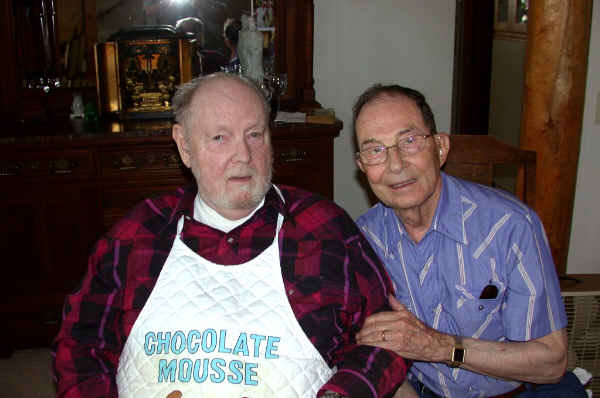 |
At our last meeting...
…at Joliet West High School, Gerry Lietz (De Paul University, retired) started us off with a buoyancy phenomenon he heard about from Melissa Coduto (De Paul graduate teaching physics at Loyola Academy). He had prepared a saturated salt solution, using non-iodized kosher salt, and poured some into a glass jar in which he had placed a golf ball, filling the jar nearly half way. Then he carefully added plain water by letting it dribble through a small hole in the bottom of a sandwich bag. The golf ball floated at the interface between the two water layers. Gerry gave us a handout that provided additional information.
| Gerry then recalled the “sink or
float?” question that is often used in regard to buoyancy. We saw that
a can of regular Coke has a mass of 384 g (can and contents) and a can
of Diet Coke a mass of 370 g. The Diet Coke floated in water and the
regular Coke sank, evidence of a small density difference. Gerry passed
around boxes of regular and sugar free Jello (powder) and the masses of
the contents (98 g for regular and 20 g for sugar free). This made us
aware again of the effect that sugar had on the golf ball and Coke
demos. |
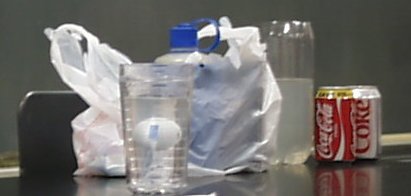 |
New Teacher Bags were presented to Brandon Smith (Simeon Career Academy High School) and Zoe Paukstys (Joliet West High School).
Debbie Lojkutz passed along this announcement from Paul Dolan and Roy Coleman. Mayor Daley and the Chicago Public Schools are hosting the second annual “Science in the City” at Daley Center on Tuesday, October 2, 10 AM – 2 PM. ISPP has reserved a booth. Any members who can come to help (and do a demo, if possible) will be welcome, Contact Paul (P-Dolan@neiu.edu<>) or Roy Colemen (coleman@iit.edu<>).
| Erik
Jurgens (Joliet West High School) showed us some glass tubes
with chemical solutions of various colors in them. When he illuminated
them with U-V light we saw the result of absorption of the U-V light
followed by emission in the visible range. He asked where this demo
might fit in the curriculum. Suggestions included the nature of light
and the study of spectra. As a follow up Gerry Lietz suggested aiming a
TV remote (I-R) at a video camera. Bill Shanks tried a green laser and
this brought up a question about the purchase procedure for the laser
pointer offered by Jasper Laser (http://www.bigha.com/sky/index.php).
Bill Blunk said to call them at 877-388-7362 and ask for their
“basement deal” - $34.97 plus shipping. |
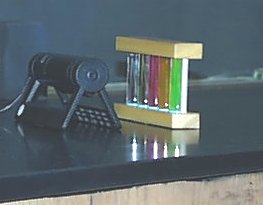 |
Art Schmidt (Northwestern University) brought a blue laser pointer. He directed the beam, and beams from red and green lasers, through colored glass pieces. He also used LEDs of various colors. We could compare transmission and absorption for these combinations. Art also has a sheet of material that emitted light after being illuminated by light from his sources, (I think this was a “Write and See” phosphorescent square from Educational Innovations.) The blue source (more energetic photons) was most effective. Bill Blunk illuminated Art’s hand placed over the sheet and we saw the “shadow” of his hand within the phosphorescing area that has been illuminated.
| Brian
Sievers (Thornridge High School) projected several pictures of
his students exploring (outdoors) the phenomenon of dropping Mentos
into a 2 L bottle of Diet Coke. (He couldn’t do this for us indoors, of
course.) He has them look at the estimated height of the stream
produced by the reaction for different numbers of Mentos candies.
(Wikipedia has an explanation of this phenomenon under “Diet Coke and
Mentos eruption.”) Brian made a nozzle that fit uniformly over the top
of the bottle (see picture). Brian also showed us some pictures and described work he has done with students getting them involved in Habitat for Humanity |
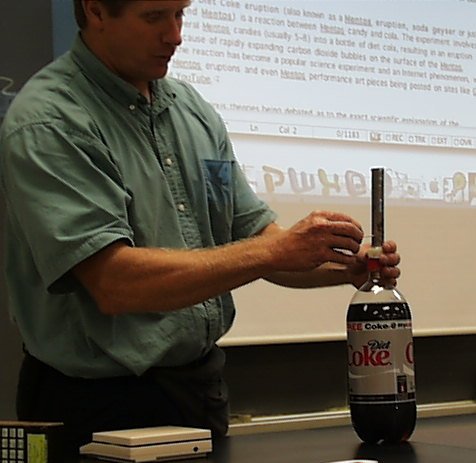 |
| Chester
Szmurlo (Lincoln Way Central High School) showed us a “toggle
ball” he found at Jewel-Osco for $1.00. When he flipped it up it, in
effect, turned inside out! We could see this because the curved plastic
outside sections (he called them “plates”) were of a different color.
He had looked inside the ball and was able, with the help of a sketch,
to describe how he thought the ball’s mechanism worked. |
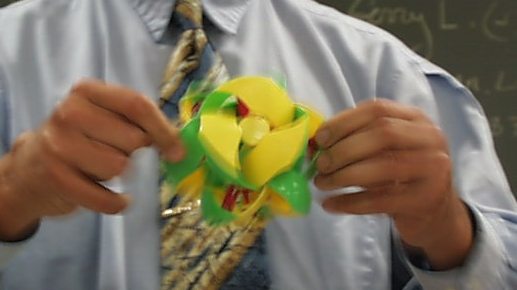 |
Stewart Brekke (CPS, retired) showed us three books on CD that he though would make interesting reading for physics teachers: Einstein, by Walter Isaacson, A Brief History of Time, by Stephen Hawking, and a third one whose title did not get into my notes.
| Joe
Kozminski and Len Weisenthal
(Lewis University) set up a magnetic accelerator: several steel balls
in a grooved track – there was also two neodymium magnets on the track.
When a ball was pushed toward the magnets and row of balls, the ball at
the end moved away at high speed. We discussed this interesting
action-reaction phenomenon but time was getting short so we didn’t
really arrive at a complete explanation. |
 |
Before we left we picked up some giveaways. For those of us who use the Vernier microphone/PVC tube experiment to find the speed of sound, there was a “dog clicker” from PetSmart. The clicker has a nice loud sharp sound that will trigger the microphone. We were also able to take bags of 12 plastic Easter eggs to use in a simulation of the Millikan experiment, along with a student experiment sheet and sample data. Our thanks to our Joliet West hosts.
Reported by John Milton
For any information regarding ISPP contact Gerry Lietz or John Milton at DePaul University, Physics Department, 2219 N Kenmore, Chicago, IL 60614, phones (773) 325-7333 or 325-4238, emails: glietz@condor.depaul.edu, jmilton@depaul.edu<> .ISPP home page: http://condor.depaul.edu/~glietz/ispp/ispp.html<>.
Return to top.
Cudahy
Science
(Physics Building) is the one with the green dome on top (Bldg. 24 on
the map).
We will meet in room 202. Signs will be posted.
<>

Directions
to Loyola University Chicago
(Parking in the high rise parking
structure is $6.00.)From the North: From north Sheridan Road: Since there will be no left turns onto W. Sheridan at rush hour, continue to Rosemont Ave. Go left on Rosemont to Kenmore and straight onto campus. Continue around Campus Drive to the high rise parking structure (Bldg 26 on the map).
From the Edens: Exit Edens Expressway at Touhy going east. Take Touhy to Sheridan Road and turn right (south) on Sheridan. Since there will be no left turns onto W. Sheridan at rush hour, continue to Rosemont Ave. Go left on Rosemont to Kenmore and straight onto campus. Continue around Campus Drive to the high rise parking structure (Bldg 26 on the map).
From downtown or south: Take Lake Shore Drive (LSD) to Hollywood (as far as it goes) and turn right onto Sheridan Road. Continue until you reach the bend in Sheridan. After the bend is a stoplight. Turn right onto Campus Drive and continue to the high rise parking structure (Bldg 26 on the map).
Via El trains: Take the Red Line north to the Loyola Stop (near the end of the line, right after Granville). This is marked CTA on the map. Cross Sheridan Road onto the campus (by building 16 on the map). Go straight to Campus Road and look for Cudahy Science (Physics Building), the one with the green dome on top (Bldg. 24 on the map).
Return to top.